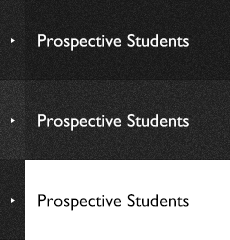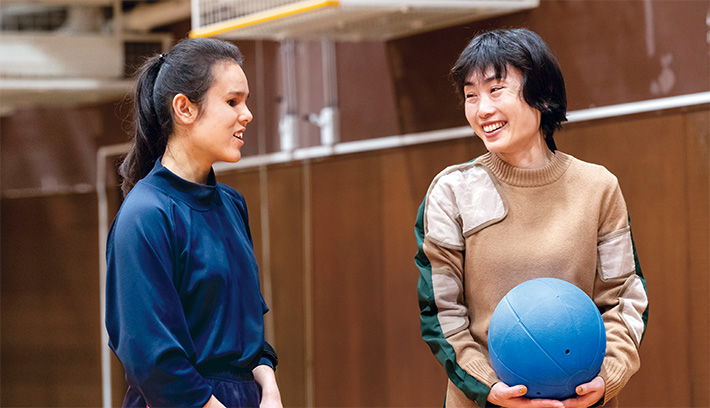
Goalball is a sport where you depend not on your eyes, but your ears.
Able to handle both offense and defense, Saki Amuro is expected to be a contender for the Japan national team.
Associate Professor Asa Ito grew up fascinated by insects and other forms different from her own, and, through conversations with people with various types of disabilities, she investigates physical differences and sports for disabled people.
This blind athlete and sighted academic got together and discussed their common experiences and new possibilities of the human form.
(Training visit: December 23, 2019, at the Tsukuba University Special Needs Education School for the Visually Impaired Gymnasium.)
(Discussion: December 24, 2019, in Shinjuku, Tokyo)
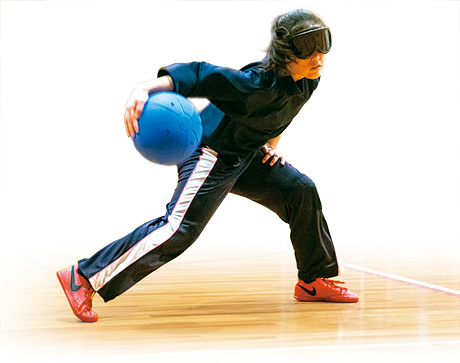
Saki Amuro practicing shooting while wearing an eyeshade.
What is Goalball?
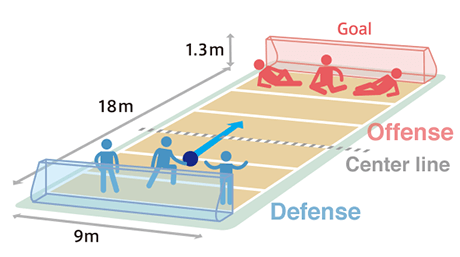
One of the official sports of the Paralympics, it is a ball sport for visually impaired people, played with three people to a team. Everyone wears eyemasks, and it is played on a court the size of a volleyball court (18 m by 9 m). The aim is to get a ball with a bell inside into the opponent's goal (9 m wide by 1.3 m high) to score a point. In the figure above, the team at the front is the attacking team. One person throws the ball, and the three people on the other team try to prevent it from going in the net. The defenders must throw the ball back over the center line within ten seconds of getting hold of it, or be penalized. So there is a rapid switching of attacker and defender. One game is played in two 12-minutes halves. As the players depend on sound, the spectators must remain quiet.
Encountering goalball, a sport for people with disabilities
ITO Thank you for making the time to talk with me today. Watching your training session was the first time I've actually seen goalball, and I was surprised how much active movement and sound there was. When did you first encounter goalball?
AMUROI first heard about the sport when I was in middle school, but only started playing in my second year at high school. It was in a physical education class at high school, after I moved to Tokyo. The teacher, who was the goalball club advisor, asked if I would be interested in trying it.
ITOYou're from Okinawa, right? What was your life like as a child?
AMUROI grew up in a rural area, so there weren't any children my own age in the neighborhood and I had to play with my one year older sister. We would play in the mud around the flowerbeds in the garden, or play with blocks. We would sometimes take a soccer ball with a bell inside to the park. I lost my sight when I was one year old, so I went to a school for the blind in Okinawa. That school catered to all ages, from infants to occupational training, so there were people there aged from 3 to 70.
ITOWith all those age ranges at school, it sounds like it was its own small town. Which reminds me: when I visited the third-year class in the elementary level at the Tsukuba University Special Needs Education School for the Visually Impaired, we all played hide-and-seek. I'd always thought of that as a game for the seeing, so I was rather shocked.
AMUROIf it's a room you're used to, you get an idea of what is where, so you know where you can hide. But if you're playing with other people who are blind, it doesn't matter if there are walls or other places to hide. If you make the slightest movement, the slightest sound, we can find you. So that's why people would often not hide, and just stand boldly in a corner of the room. [Laughs]
ITOI see! [Laughs] Another thing was when the girls were touching a 3D-printed object and said it was cute. I was intrigued—how much of it could they perceive through touch alone? I'm researching body theory. I'm interested in how one sees the world without vision, what senses are used, so I talk with people who can't see. But for visually impaired people, circumstances such as whether they are completely blind or just have poor vision, whether they were born with it or it happened later, changes how they see things, how they grasp the world, completely.
AMUROIndeed. I would imagine that those girls considered round shapes to be cute. This is something I sensed after starting high school, but there are a lot of people with really attuned senses at Tsukuba University Special Needs Education School for the Visually Impaired. They can hear the tiny sounds a ball makes when it's rolling, and can tell exactly where the ball is. Or they put a baseball in a plastic bag and use that to generate sound through air resistance. When I was in Okinawa, nobody was coming up with ideas like that, and I was like "what are these people!?" People with great learning abilities or with good brains can do anything.
ITOThat must have been a major culture shock. When your environment changes that much, you change inside as well, right?
AMUROI was no longer able to use the excuse "I can't do it because I can't see." And I had this chance to try goalball. But the team I joined sent athletes to the Japan Championships each year, and that year, there weren't enough people to send. So I was able to take part in a championship right away. In my debut game, we lost completely, ten to zero. We couldn't get hold of the ball at all, and that frustration at not being able to stop it has helped me get where I am today.
Seeing your surroundings through sound and touch
ITOThe ball you use in goalball is very hard, right? Like a stone. What sort of skills do you need to stop the ball? Do you see it like making a wall?
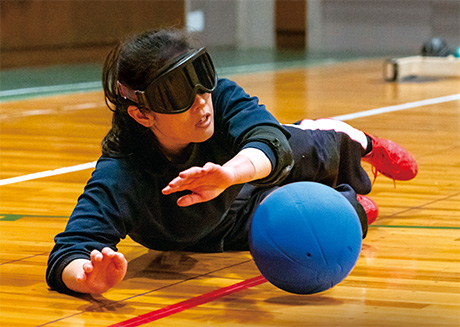
Carefully checking posture in defense practice.
AMURORight. If you lean over, the ball rebounds and ends up in the goal, so you need to make your body firm like a wall, concentrating on being perpendicular to the ball and floor. When the ball comes bouncing, you drop to your elbow, keep your torso raised, and cover with your hand above to keep the ball from getting past you.
ITOIt seems like you can try all sorts of attacks: bounces, grounders, add spin, use centrifugal force to add speed. All depending on the player and the situation.
AMUROThe bell rings when the balls rolls, so you can tell when there is topspin. But with sidespin, the bell stays in the center, so there's no sound. Topspin is for speed, and sidespin is for changing course or suppressing sound.
ITOIn the sense of reading each other, it's close to the psychological battle between pitcher and batter in baseball. In that, it's important to know where each of the players is. How much can you tell about your surroundings from sound?
AMUROI have a birds-eye grasp of the whole court. In play, the sense I use is sound, but the image I create is through touch. For example, when I hear the ball, I know that the sensation of touching the ball is coming. I know the size of the ball from touching it, and so I know a ball of the same size is coming towards me.
ITOThe ball you see with your eyes gets larger as it gets closer—that's the difference, right? Touch is information you gain by touching something with your own hands, so it doesn't include position information. For people who can see, it is hard to understand how the sense of touch can be separated from yourself, then come towards you. Perhaps sound is changed into touch. For example, what image do you get when you hear the sound of coffee being poured? It must be natural for you, but I imagine it would be hard to put into words.
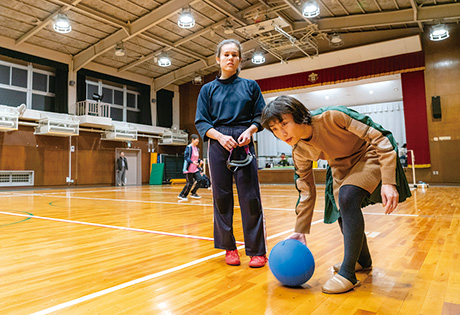
AMUROHmm. Perhaps the combination of sensations of a coffee cup you've touched, sticking your finger in the cup, and sensing how the liquid is filling up.
ITOI see, so people who can see can also create these combinations of sensations in their heads. But for sighted people, we visualize things, and for you, the image would be one of touch.
AMUROWhen I hear the ball bouncing, I can get three-dimensional sensations of myself taking the rough, hard ball and hitting it on the smooth wood-grained floor.
ITOI think I'm starting to understand. The first time I touched a goalball ball, my level of understanding about the strong shock when it bounces increased considerably. You're right in that if I'd never touched a ball, I wouldn't feel any power there. I can see how it's not using sound to grasp everything, but a combination with touch. My view on the sense of touch has changed.
Experiencing sports beyond the self
AMUROIto-sensei, what did you feel the first time you touched a goalball ball?
ITOTo me, it felt like this was a powerful sport where power and power clash. Why is the ball so hard?
AMUROIt has holes so we can hear the bell, which means it can't be pumped up with air, so it's like a shell. Goalball didn't start out as a sport, but was created as rehabilitation for injured soldiers, so the ball was designed not to bounce too much.
ITOThe lines on the court have tape applied over threads, creating bumps. You can always feel them with your hands or feet, but can you feel them when wearing shoes?
AMUROWe can. If you step on them with both feet and stand up straight, you'll notice. The thinner the soles, the better, but we're not using shoes for goalball but indoor shoes for futsal. If we change our shoes, it'll be harder to grasp the sensation at first.
ITOYour tuning gets thrown off, right? Tools are clearly very important. How do you feel about the convenience of white canes and braille that you use in your daily life?
AMUROIt's hard to use a cane in the big city, because if it's crowded it can get caught up in the person ahead of me and snap. I like braille, because I can understand it at my own pace, unlike when things are read out, which only go at a set pace.
ITOA man called Seiichi Tejima, who helped found Tokyo Tech, is famous for having brought back braille writer machines from overseas to Japan, back when there was no Japanese version of braille. He understood the educational meaning of braille, and knew how important it was to incorporate in schools for the blind in Japan.
AMUROThere's all sorts of visually impaired people, and all sorts of approaches from researchers as well. Exactly what sort of research do you do, Ito-sensei?
ITOAt the moment, I'm carrying out joint research with NTT on sports spectatorship. The very word "spectatorship" heavily implies relying on vision, but just watching it is only one facet, and won't allow you to understand the athletes' sensations. Goalball helped me change my views after touching the ball. I'm looking for new ways to be a sports spectator using senses other than vision. In that sense, I think it would be better to avoid phrases like "spectator" sports. One major trial we're doing is the Mienai Sports Guide we've put out on the internet.
AMUROWhat is it about?
ITOIt's a way to sort of translate the nature and sensations of ten different sports using simple objects from around the home like you can get at a hundred-yen store. Amuro-san, have you ever tried fencing?
AMURO I've no idea what that is….
ITOIt's a sport where you face off with another person and try to stab them with flexible swords. It is a fast-moving sport, and they use sensors to detect whether the blade has contacted the other person, as the movements can be too fast for the human eye to see. To let blind people experience what fencing is, we talked with a medalist and came up with a 'translation' using wooden pieces shaped like the letters C and H. You hook them together like a topological puzzle, then one person tries to free their letter, while the other person tries to prevent that. In this way, you can experience the sensations of the sword striking or parrying. Fencing isn't about just shoving your sword in through brute strength, but requires you to use your hands and wrists to match and deflect your opponent's movements. Amuro-san, you get an image of it through your experiences of touching a ball. In fencing, too, watching and listening offers a surface understanding, but we can use other tools to experience it in terms of touch, giving us more information and clarity. In other words, you have some personal experience with the sport. I think this might be close to how you create images from touch.
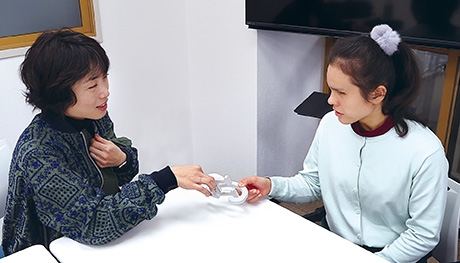
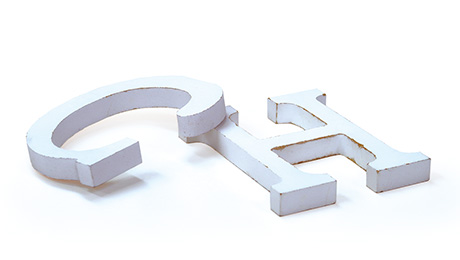
Fencing from Mienai Sports Guide using wooden alphabet shapes. Amuro and Ito's games ended in three straight wins by Amuro. Ito commented, "Her wrists were flexible and she didn't put any unnecessary pressure on them. She might have been the strongest opponent I've faced!"
AMUROLike combining sound and touch, understanding is deepened by adding the sensations of the athletes, right?
ITOExactly. In terms of technology, there's a lot that Tokyo Tech can contribute. For example, something like virtual reality which combines sight and touch. What sort of things do you sense when you're in the crowd at a goalball game?
AMUROIt feels like I'm playing. It's like I get the same sensation when a player throws the ball as I do when I throw it.
ITOVision is a first-person perspective seen from yourself, or a second-person perspective seen from the other person. For example, it's hard to know what you look like from the perspective of someone in front of you. But touch doesn't depend on the person, whether first, second, or third. Senses that can freely change their perspective are interesting. You can 'possess' the player through the senses you have when you are playing. That's an unknown realm for people who can see. I'd love to do more research on how senses can go beyond the self.
Technology and sports for people with disabilities
ITOAt the Lighthouse facility in San Francisco, they have a lab where visually impaired people can make things they want using 3D printers and other electronic work. They consider it important to create an environment for people with disabilities to learn how to use technology.
AMUROWhen someone with a disability uses a tool, they hope it can solve their problem. So it doesn't have to be something high-tech—there are plenty of times a low-tech solution is fine.
ITOIndeed. Even if we could make a white cane that sends out ultrasound, that wouldn't necessarily be the ideal solution. The latest technology isn't always going to solve the problem. One of my friends made a prosthetic hand for use at buffet parties, the sort where you eat standing up. That person was born without one arm, and had never felt handicapped before. The only issue was these buffet parties, which assume you can use two hands, one to hold the plate, one to eat with. So this prosthesis only went down to the elbow, and had a flat surface at the end where paper plates could be put. In other words, it was nothing like our arms. For that person, that prosthesis was the right solution. Being aware that there is always more than one answer is important both for society and technology, and helps bring about new innovations.
AMUROWatching sports is the same. I would imagine very few non-disabled people have played goalball, so I'd like there to be more chances for them to try it. Goalball has evolved from medical treatment to welfare, and now to a sport, but I think it would be interesting if we could combine it with technology and experience it in VR or games. I'd like everyone to enjoy sports for people with disabilities in the same way as sports for non-disabled people—playing them, watching them, or playing games about them.
ITOIf they learn about the psychological and intellectual aspects, like reading your opponent, they'll be able to see how a team is trying to get points, and I think they'll be able to empathize. If they experience it, they'll be able to understand the sensations of the players. I think technology still has a lot to contribute when it comes to this sort of new view of sports.
The surprising connection between Tokyo Tech and braille
Seiichi Tejima and Braille
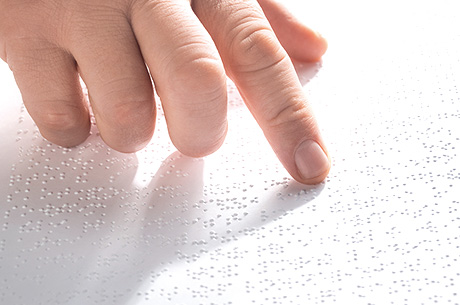
Seiichi Tejima brought back a braille writing machine and a book from overseas, and reformed the preparation of teaching materials using those from overseas as templates. Convinced that education in Japan would open up pathways, he argued that "even if one has an impairment of the senses, the spirit is no different to that of one without an impairment."(1) Tejima made huge contributions to the progress of technical education in Japan as headmaster of Tokyo Technical School and Tokyo Higher Technical School, the forerunners of the current Tokyo Institute of Technology. There is a statue of Seiichi Tejima at Ookayama campus.
- *1
- Kinoshita, Tomotake, "Tenji Izen 18-19 Seiki no Nihon ni Okeru Mojin no Shintai to Moji Hyoki Gijutsu no Kosa (Before braille: the intersection of writing technology and the bodies of the blind in 18th and 19th century Japan)," Itteki No. 26, p.85, 2019
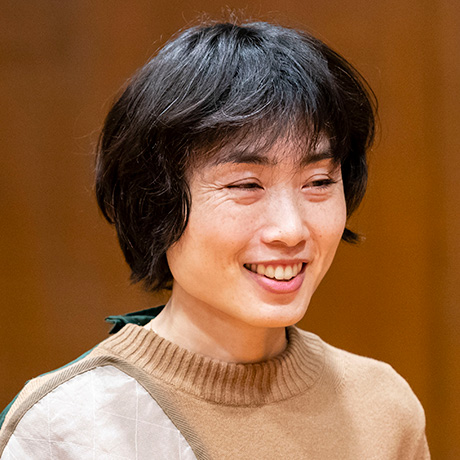
Asa Ito
Director, Future of Humanity Research Center, Institute of Innovative Research, Tokyo Institute of Technology
Associate Professor, Institute for Liberal Arts
Her specialization is aesthetics and contemporary art. While she wanted to become a biologist, she switched to an arts major in her third year at university. In 2010, after obtaining the required credits, she withdrew from the Department of Aesthetics, General Culture Division, Graduate School of Humanities and Sociology, the University of Tokyo, and was awarded her doctorate in Literature that same year. After being a Japan Society for the Promotion of Science Research Fellow, she was appointed as associate professor at Tokyo Tech in 2013. From March to August 2019, she was a visiting researcher at MIT. In February 2020 she was appointed director of the newly-established Future of Humanity Research Center. Her major works include "Valéry no Geijutsu Tetsugaku aruiwa Shintai no Kaibo (Valéry's Art Philosophy or Dissection of the Body)," "Me no Mienaihito wa Sekai wo Do Miteirunoka (How do Those Who Cannot See the World?)," "Me no Mienai Athlete no Shintai-ron (New Body Theory for Blind Athletes)," "Domoru Karada (The Faltering Body)," and "Kiokusuru Karada (The Remembering Body)." She is a supervising faculty member for the Social and Human Sciences graduate major in the School of Environment and Society.
Ito Laboratory
Asa Ito's lab carries out inter-disciplinary research on art, philosophy, and the body, with a specialization in aesthetics. Through dialogues with people with various types of disabilities, she studies sensation and the body. She launched the Mienai Sports Guide, a joint research project with NTT, in June 2019. This publicizes the results of their project to 'translate' the bodily sensations of athletes.
Ito Laboratory
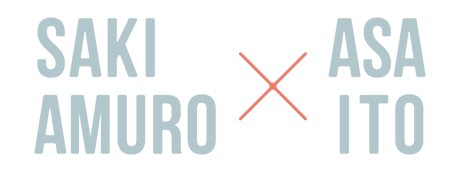
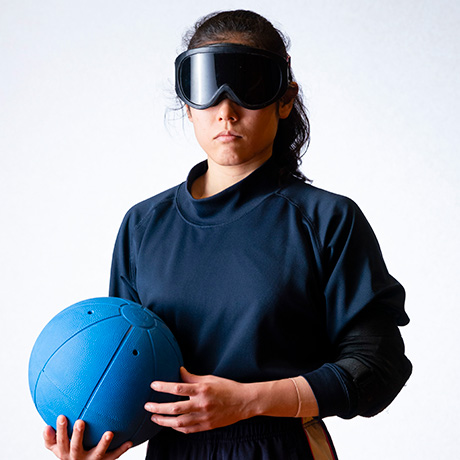
Saki Amuro
Member of Team Fuzoku goalball team
Born in 1993, Yaese, Okinawa. Graduated from the School of Law, Meiji University, in 2015. She lost sight in both eyes due to illness at age 1. She went to high school at the Tsukuba University Special Needs Education School for the Visually Impaired in Bunkyo Ward, Tokyo, and started goalball seriously from her second year. She is a member of Team Fuzoku (Special Needs Education School for the Visually Impaired), and her positions are Center and Right. The main events she has been in are the 2015 IBSA Goalball Asia/Pacific Championships (China), where her team came first, the 2016 Japan Para-Sports Goalball Championship, where her team came third, the 2015 and 2016 Japan Goalball Championships, where her team came top, the 2017 Japan Para-Sports Goalball Championship, where her team came top, the 2017 IBSA Goalball Asia/Pacific Championships (Thailand), where her team came top, the 2017 Japan Goalball Championships, where her team was runner-up, and the 2019 Japan Goalball Championships, where her team placed third.
The Special Topics component of the Tokyo Tech Website shines a spotlight on recent developments in research and education, achievements of its community members, and special events and news from the Institute.
Past features can be viewed in the Special Topics Gallery.
. Any information published on this site will be valid in relation to Science Tokyo.














